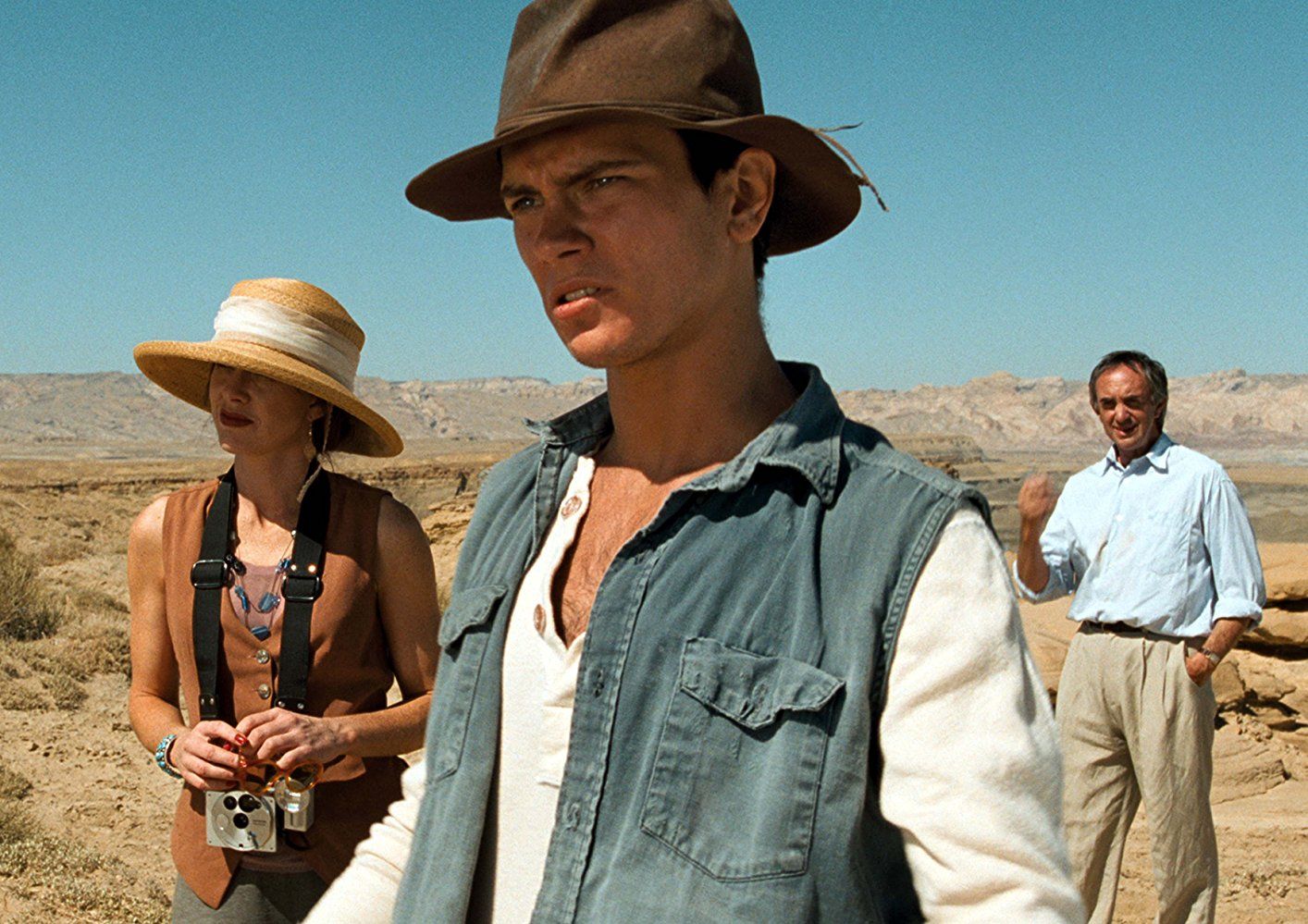Dark Blood (2012): A Movie Review
George Sluizer's brooding, desert-based drama seemed doomed after River Phoenix's untimely death in 1993. Its eventual 2012 release reveals a cinematic gem.

We shot the movie Dark Blood in 1993. Unfortunately River Phoenix died before the end of the shooting. For me, the director of the movie, and many others it was a very sad and tragic experience to lose such a gentle and gifted actor. When I got severely ill myself I had the urge to put the material we had shot together while I still could. If I could make a comparison, we had a chair with two legs and I wanted to add the third leg to edit and preserve what we had achieved. The fourth leg will always be missing, but the chair would then be able to stand upright. Please take pleasure in the unfinished film Dark Blood.
So opens Dark Blood, with director George Sluizer introducing a movie that found its release in 2012, nineteen years after its production. Sluizer died two years later, and from his introduction we can surmise he intended its release as something of a final act.
I was lucky enough to attend a screening with him in attendance on its release. After the credits rolled, and from a wheel chair, the French-born Dutch filmmaker took questions from the audience and spoke with passion about the project and its production. I’ve been fascinated with the movie ever since.
Death is at the heart of the movie, flowing thematically through the script and infusing the air of its hostile desert landscape. That its creation is closely related to the deaths of its director and lead actor in real life could almost make you wonder if it possesses some dark energy that leaked out during its creation.
It’s impossible to fully separate Dark Blood from the facts of its production, and specifically the tragic death of River Phoenix. The movie’s introduction even brings them into the text itself. This makes it something of an oddity in cinematic history. A strange, radiant (or radioactive) gem that appeared to be lost to those same facts.
The movie shows Phoenix in the upswing of his career, increasing his range and screen presence in new and interesting ways. It’s one of his most intriguing and memorable performances, showing facets of his acting skills we hadn’t seen before, being the darkest role he played.
Top billing is shared with Jonathan Pryce and Judy Davis—who are also fantastic. The trio of actors take up the lion’s share of screen time, with only minor roles further down in the cast. It gives the movie qualities of a stage play. The movie matches a small budget with a lot of fascinating elements and a boat load of acting talent.
Sluizer substitutes scenes he wasn’t able to shoot before Phoenix’s death with brief narration of action and dialogue, spoken over silent footage or montages of freeze frames. The approach is surprisingly functional. Sluizer imparts a fitting tone in his narration, and it starts to feel like an experimental–but–intentional dramatic device. It also gives the movie a deeply personal feeling. It sounds crazy, but there’s something nice about a director stepping in to personally narrate some events of the story. It has a touch of Orson Welles about it.
On the other hand, if this was an intentional device you would choose more trivial or ancillary events to narrate. Some of the missing scenes are important to developing the relationship between Boy and Buffy. Alas, nothing to be done there. What happens in those scenes is clearly imparted, and the sequences are brief and few. They get the job done.
The plot picks up on married couple Buffy (Davis) and Harry (Pryce) setting off from Hollywood on their second honeymoon. Buffy is a former playboy bunny and showgirl, and Harry an out-of-work actor. They hit the road in a vintage Bentley, an old British luxury car that predictably breaks down in the middle of the desert. Stranded on a road that rarely sees traffic, Buffy is able to find them help at a remote cabin inhabited by Boy (Phoenix).
A short driving distance away is a ghost town, and St. John, a newly constructed village the Native American inhabitants of the old town were relocated to, after it became radioactively contaminated. Nuclear tests were conducted closeby in the recent past.
Boy lost his wife to cancer, caused by the radiation, and now lives alone. He makes what look like Native American totems or fetishes—figures made out of wood which he believes possess spiritual powers. He arranges them on a shrine in a bunker he has made to prepare for the apocalypse, which he believes is imminent. He’s a self-styled survivalist. A young widower living in self-imposed exile from the modern society.
Awaiting car repairs from the nearby town’s mechanic, Buffy and Harry find themselves trapped at Boy’s cabin. He dismisses requests to drive them to the nearby town for various reasons that start to feel flimsy. Tension builds as it becomes clear Boy is deeply attracted to Buffy, and sees her stumbling on his cabin as a fateful event.
Phoenix combines rural, spiritual, eccentric, and menacing traits in Boy in a way that somehow gels and convinces. He plays the part with inner conflict and contradiction—strong and vulnerable, gentle and violent—and fully inhabits the role. His cadence and timing is as off-beat as it is on-point, both volatile and charming. He brings out sympathetic and moral qualities in a character who often seems psychologically disturbed and violently menacing.
Pryce plays a middle-aged actor with an overly-civilised, book smart demeanour. Deeply cynical and easily irritable. Money and status are his primary survival tools, which disappear the moment his Bentley breaks down in the desert. Frustration and a slow-building jealous anger are palpable, forming over time in a convincing way. Pryce uses fleeting looks and gestures to enrich his performance, adding dramatic interest to moments that might otherwise seem insignificant.
Davis plays a woman at the tail-edge of her youth. A mother and wife who was once a Playboy Bunny for a stint. Her interactions with Boy, a much younger man than her husband and attracted to her with an intensity of passion he lacks, lead her to be in moments curious, flattered, sympathetic, off-put, and in fear of her safety. Her character is on an emotional rollercoaster from the moment they arrive, and Davis expertly switches between these conflicted emotions and assessments, drawing the viewer deep into the central conflict.
Narratively, death looms over everything. The nearby radioactive ghost town, rendered uninhabitable by nuclear tests that have also caused the death of Boy’s wife, foreshadows the apocalypse he prepares for. The desert setting is shown to be a place where life barely survives. Boy goes out to hunt, but there is little alive to be hunted—lizards, snakes, and small rodents. References to the genocidal destruction wrought on Native American peoples by colonialism and its after-effects add to the film’s morbidity. The local gas station attendant mourns the lack of traffic passing through, explaining how busy things were when the nuclear test site was operational. Buffy is constantly reminded of her past career, and refers to a picture of her from this period as ‘a ghost from the past.’ Harry hasn’t worked in over a year. Everything seems to be in in its deathroes.
The initial encounter of Buffy and Harry with Boy quickly makes the theme explicit. Boy throws stones at titanium castings hung around his porch, making them ring in myserious, gong-like tones.
‘It’s like right out of the belly of the beast or something, huh? That’s death’s music you’re hearing.’
While the film is obsessed with death, it deals with the subject in such an entertaining way. The story feels dangerous and mystical, rather than bleak. It’s painted in bold, pulp fiction tones, with characters full of passion, spirit, and wilfulness butting heads against each other in the desert sun. It borrows formal and thematic elements from the Western, quite indirectly, and gets cinematic results.
Boy is obsessed with the idea of the dark forces of the outside world, there to be fought. He sees Harry and to a lesser degree Buffy as representing the world he has isolated himself from, and in that sense, a part of those dark forces. In turn, Harry is obsessed with getting the hell out of his cabin by any means possible, to take back control over their situation.
The movie leaves its viewer to think about the power dynamics between the trio, and perhaps find parallels to themes of nuclear apocalypse in the larger world. Can dark forces be willed into being through obsessing over them? And are we too quick to see people who represent starkly different ideas and cultures as mortal threats?
We’re not given any easy conclusions to draw, but it leaves you puzzling over the various dual natures at play. The comparison it invites the viewer to make is engaging.
Sluizer was right to strive to give the movie a “third leg” while he still could. It deserves to be seen.
It’s an original apocalyptic tale, with thought-provoking themes and highly memorable performances.
James Lanternman writes movie reviews, essays, and moonlit thoughts. You can reach him at [email protected].
Previously… Changes Break or Make a Nation, and Trump Will Stand Firmly at His Station
